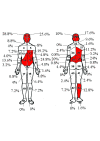Survivors of war in northern Kosovo (III): The role of anger and hatred in pain and PTSD and their interactive effects on career outcome, quality of sleep and suicide ideation
- PMID: 22846511
- PMCID: PMC3492011
- DOI: 10.1186/1752-1505-6-4
Survivors of war in northern Kosovo (III): The role of anger and hatred in pain and PTSD and their interactive effects on career outcome, quality of sleep and suicide ideation
Abstract
Background: The management of chronic debilitating health conditions after trauma remains a challenge in post-conflict settings. The study aimed to expand current understanding of the diagnostic overlap of pain and PTSD and explore their independent and interactive effect on career change, sleep disorder and suicide ideation. The role of anger and hatred as contributing factors to the persistence of pain and PTSD were also examined.
Methods: 125 victims of torture and massive violence identified in a household survey took part in the in-depth assessment. Socio-demographic data and information on trauma, emotional disturbance, injuries and medication history were collected. PTSD was diagnosed according to DSM-IV criteria. Pain was assessed using the McGill Pain Questionnaire and the Margolis Pain Diagram.
Results: Nearly 95% participants experienced pain during the last 2 weeks, 47% were diagnosed with PTSD, 50% were taking medication against depression and anxiety. There is substantial overlap of pain, PTSD and emotional disturbance. Injury history, PTSD and negative emotions were related to the pain score and the number of pain locations. Anger, hatred or an inferiority complex particularly amplified pain experience. Headache was constant and especially prevalent in those with recent experience of anger, aggressiveness and hatred. The risk of having chest and abdominal pain within 2 weeks was very high in those who had chest injury and had recently been crying. An increased risk of changing jobs or stopping work or schooling due to depression or injury was observed for those with a higher pain score, and for pain in neck, shoulder and upper limbs. The prevalence of sleep disorders was 80%, that of suicide ideation 70%, and these were found to be associated with greater pain and anger. PTSD was also related to suicide ideation.
Conclusions: The findings provide an overview of pain characteristics in individuals with PTSD and injury and confirm the hypothesized effects on career outcome, sleep disorders and suicide ideation. The study revealed a high level of persistent anger and hatred. The findings suggest the need for new approaches to rehabilitation in a post-war setting, including ways in which to address collective emotional hurt in the society.
Figures
Similar articles
-
A novel bio-psycho-social approach for rehabilitation of traumatized victims of torture and war in the post-conflict context: a pilot randomized controlled trial in Kosovo.Confl Health. 2017 Feb 8;10:34. doi: 10.1186/s13031-016-0100-y. eCollection 2016. Confl Health. 2017. PMID: 28191034 Free PMC article.
-
Suicidal ideation, post-traumatic stress and suicide statistics in Kosovo. An analysis five years after the war. Suicidal ideation in Kosovo.Torture. 2009;19(3):238-47. Torture. 2009. PMID: 20065542
-
Types and Number of Traumas Associated With Suicidal Ideation and Suicide Attempts in PTSD: Findings From a U.S. Nationally Representative Sample.J Trauma Stress. 2015 Jun;28(3):183-90. doi: 10.1002/jts.22010. Epub 2015 May 19. J Trauma Stress. 2015. PMID: 25990916
-
[Posttraumatic stress disorder (PTSD) as a consequence of the interaction between an individual genetic susceptibility, a traumatogenic event and a social context].Encephale. 2012 Oct;38(5):373-80. doi: 10.1016/j.encep.2011.12.003. Epub 2012 Jan 24. Encephale. 2012. PMID: 23062450 Review. French.
-
[The Gulf War Syndrome twenty years on].Encephale. 2013 Oct;39(5):332-8. doi: 10.1016/j.encep.2012.11.003. Epub 2013 Jan 23. Encephale. 2013. PMID: 23351934 Review. French.
Cited by
-
Sleep Quality and Psychological Status in a Group of Italian Prisoners.Int J Environ Res Public Health. 2020 Jun 13;17(12):4224. doi: 10.3390/ijerph17124224. Int J Environ Res Public Health. 2020. PMID: 32545743 Free PMC article.
-
The Unhappy Shoulder: A Conceptual Review of the Psychosomatics of Shoulder Pain.J Clin Med. 2022 Sep 19;11(18):5490. doi: 10.3390/jcm11185490. J Clin Med. 2022. PMID: 36143137 Free PMC article. Review.
-
Risk factors associated with pain among community adults in Northwest China.J Pain Res. 2019 Jul 2;12:1957-1969. doi: 10.2147/JPR.S193773. eCollection 2019. J Pain Res. 2019. PMID: 31308728 Free PMC article.
-
Conflict and Health: seven years of advancing science in humanitarian crises.Confl Health. 2014 May 12;8:7. doi: 10.1186/1752-1505-8-7. eCollection 2014. Confl Health. 2014. PMID: 24843382 Free PMC article. No abstract available.
-
Immediate and evolving emotions among directly exposed survivors 7 years after the Oklahoma City bombing.Npj Ment Health Res. 2024 Aug 14;3(1):38. doi: 10.1038/s44184-024-00081-y. Npj Ment Health Res. 2024. PMID: 39143389 Free PMC article.
References
LinkOut - more resources
Full Text Sources
Medical



